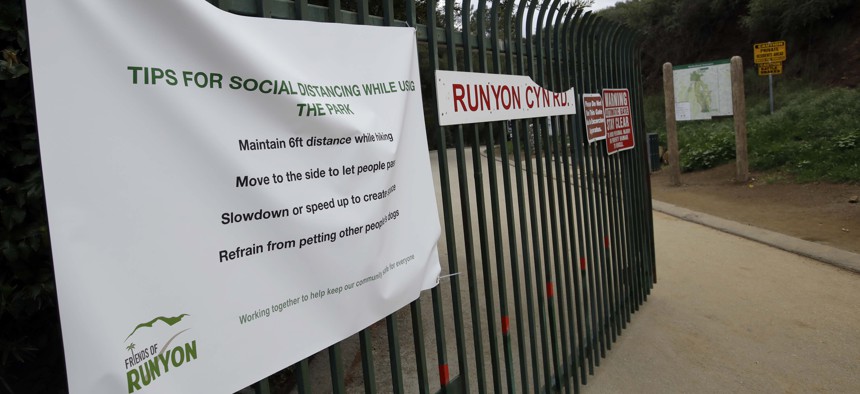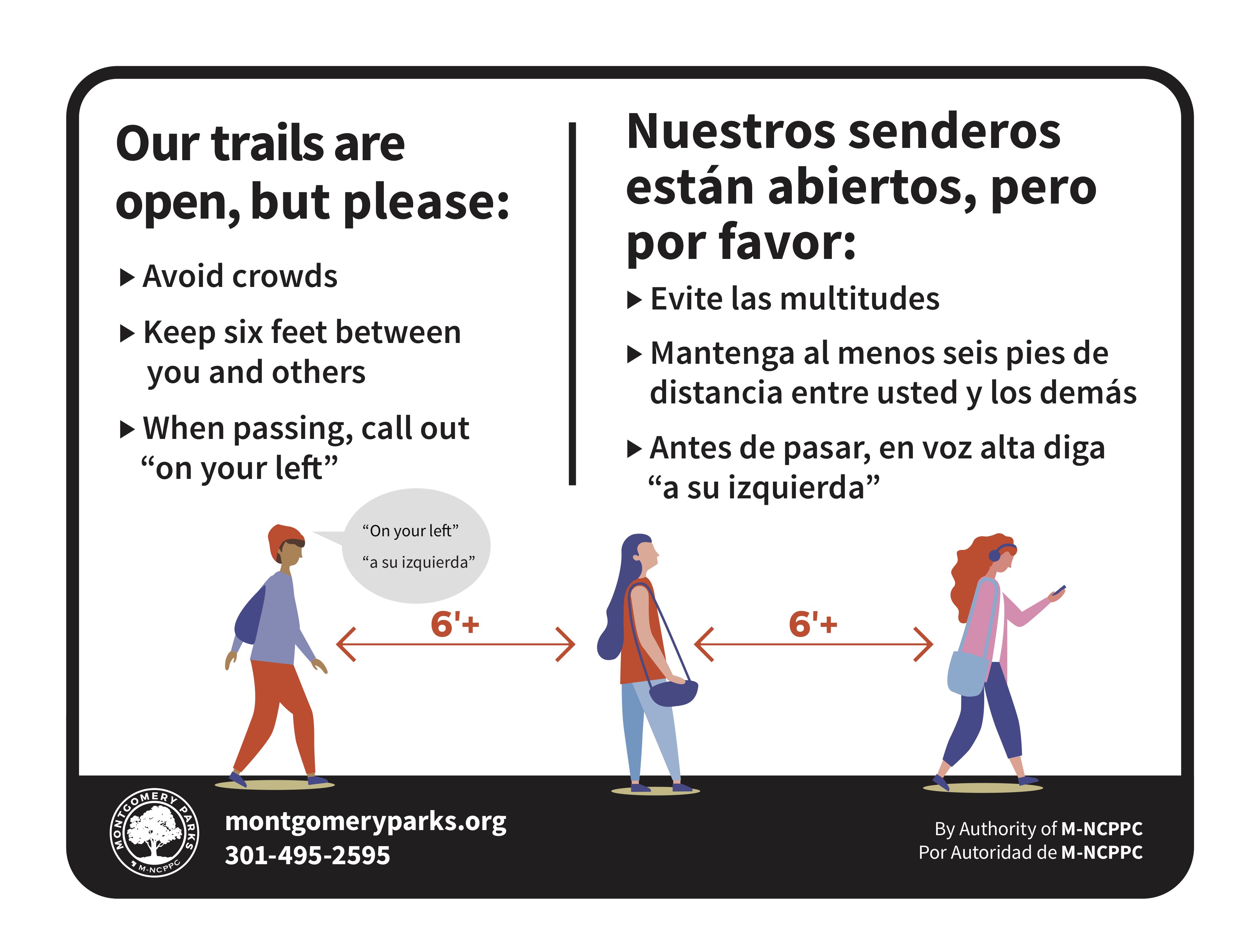Trail Use Way Up as Coronavirus Stifles Other Activities

A signs issues instructions for social distancing as Runyon Canyon park announces a closure Wednesday, March 25, 2020, in Los Angeles. AP Photo/Marcio Jose Sanchez
“People are craving outlets for their physical and mental well being,” said an expert. But this has created concerns that people are too crammed together in these open spaces.
Public trails in parts of the U.S. are seeing a surge in use amid the coronavirus outbreak, offering a respite to Americans who are otherwise mostly stuck cooped up in their homes.
This trend has left agencies overseeing parks and trails in a position where they’re trying to manage heavier visitation, while also helping to ensure that people are taking precautionary “social distancing” measures to avoid spreading a highly contagious disease.
In some places, like Los Angeles, authorities are opting to close trails to cut down on the public health risks that can arise from crowding.
All over the country, governments have ordered businesses to shutter, restricted gatherings and urged people to limit their travel to essential trips, like going to the grocery store.
But, in general, it’s still considered okay to go for walks, runs and bicycle rides, so long as people take care to keep a distance of about 6 feet between themselves and others. So it’s perhaps unsurprising that more people are taking to some hiking trails and bicycle paths.
The Rails-to-Trails Conservancy analyzed 31 trail counters around the country for the week ending March 22 and found trail usage shot up by nearly 200% from the same week in 2019.
“This just shows how much people are craving outlets for their physical and mental well being during this time of quarantine for many of us,” Elizabeth Thorstensen, the conservancy’s vice president of trail development, said Thursday during an online event.
In King County, Washington, the parks and recreation department said this week it was closing parks, and would lock parking lot and trailhead gates. But the department also conceded that it doesn’t have the resources to actively enforce the closure or social distancing rules.
People will still be able to walk into parks and on backcountry trails. The department is urging them to follow the public health guidelines.
“We’re seeing massive use of our trails,” said Gabe Avila-Mooney, who works in the department’s business development division. “It's been hard to get people to maintain that social distance,” he added. "Everybody from our staff in the field, they've been concerned.”
On Wednesday, Washington state's Department of Natural Resources announced the lands it manages would be closed to recreation activities, beginning on Thursday.
"This was not an easy decision," Commissioner of Public Lands Hilary Franz said in a statement. "But, I cannot ignore the unfortunate reality of what we saw this weekend: crowded trails, people shoulder to shoulder, and large gatherings."
Washington's Parks and Recreation Commission and its Fish and Wildlife department this week also shut down all state-managed parks, wildlife areas, and water access areas for at least two weeks.
Sean Dougan is the trails development program manager with the East Bay Regional Park District, in the San Francisco Bay Area. The district oversees about 1,330 miles of trails across more than 123,000 acres of land in areas that range from urban to rural.
“It's very difficult to close these types of facilities,” he said.
Dougan said the district has about 50 automated trail counters, mostly on paved trails, that showed average traffic roughly doubled within the first week of a “shelter-in-place” order in the region.
“We're trying to find the balance between keeping our staff healthy and safe,” he said, “and also keeping the trails and parks open.”
The district initially just tried to keep parks open like they were normally, Dougan said, but quickly saw use that exceeded holiday levels. Now, he said, the plan is to close certain “hotspots” for activity. About 30 of the district’s 73 parks are being affected by closures. All the regional trails will stay open, at least for now.
Part of the problem in Dougan's view is that some people haven’t been taking the advice of public health authorities on social distancing seriously enough. This leaves parks managers in a tough spot.
“Right now, you get to go use the trails and parks,” Dougan said. “If you abuse it, you're going to lose it.”
Darren Flusche, a planner with the parks department in Montgomery County, Maryland, said the parks and trails there are open, but indoor facilities are closed and events are suspended.
He described some of the steps his agency is taking, and considering to ensure people adhere to social distancing guidelines. This includes messaging on social media, and putting up signs that tell people trails are open, but that they should keep distance between one another.
The department is also encouraging people online to check out trails they haven’t used before to cut down on crowding in more popular areas. To help, they're offering a map of trailheads.

It’s also possible, Flusche said, that park staff might draw six-foot chalk circles at busy trail intersections so people have a better sense of whether they’re getting too close.
Thorstensen said she’d heard from a trail manager who was trying to remove benches from trailheads to prevent congregation.
In some places, park bathrooms have been locked and trash collection in outdoor areas has been dialed back.
Flusche highlighted steps his department is taking to keep workers safe, like encouraging trail crews not to share vehicles, and allowing them to show up directly to worksites from home, rather than reporting to headquarters.
While regular maintenance is not happening currently in the areas his agency manages, Dougan noted that workers are still carrying out tasks like brush clearing, tree-trimming and creating firebreaks, as they prepare for California’s upcoming wildfire season.
The Rails-to-Trails Conservancy is working on some resources for places interested in closing down streets to cars during the public health crisis to provide more space for people looking to get out on foot. Some cities have done this already, here in the U.S. and abroad. Thorstensen cited Bogota, Colombia and Philadelphia as two examples.
This story was updated to include additional information about state park and land closures in Washington state.
NEXT STORY: Local Government's Still Open—Remotely






